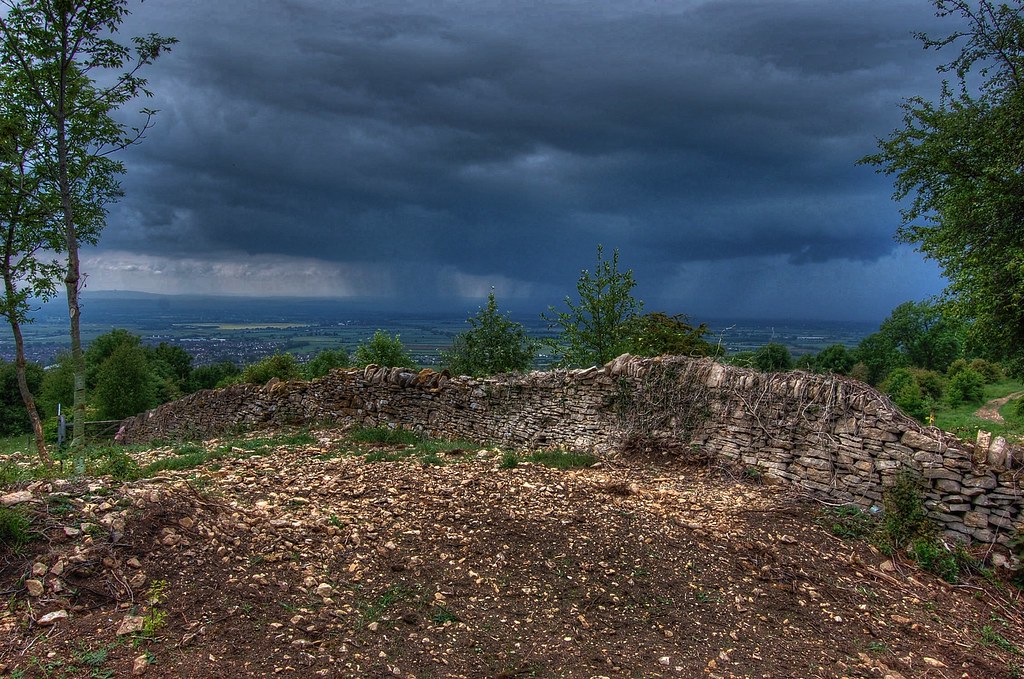
A thunderstorm chucks its load on the Severn Valley (and shortly afterwards, on me) during my walk on Sunday. Normally you get a spectacular view of the Malvern hills from here, but they are swamped!
I rarely blog about anything that isn't in my own garden, but it's worth making an exception sometimes. Not least because I ought to mention occasionally that I have an interest in native British wildflowers (and have a Flickr set of my best photos). And that I'm also lucky enough to live in the Cotswolds, a designated Area of Outstanding Natural Beauty, so I have no excuse not to go out and gawp at them.
I don't have to go very far to find them. Cheltenham sits within a cosy semicircle of hills which form a continuous ridge around it. The ridge gives the town a beautifully sheltered climate and keeps frosts in my garden to a minimum. And the ridge itself is mostly grassland overlaying beautiful honey-coloured limestone which makes a wondrous habitat for wild flowers and butterflies. All of the Cotswold hills have their own unique character and variations in plant life, and when I feel the need for a botanical frenzy I tend to go to the quieter ones which the tourists (and even most locals) don't know about. My favourite is Nottingham Hill, which is a spur at the northern end of the ridge.
Nottingham Hill is a very special place to me. The whole of the top is an iron age hillfort, but you can't see it from the ground because it's too big to view in its entirety. The earth is full of natural holes, dips and openings. The lower slopes (particularly on the N and E sides) are liberally dotted with springs, some of which are the sources of local brooks and streams. Most of the trees around the fort are magical trees, elder, hazel or thorn. There's also a very strange grove on the southern edge just below the fort where almost all the trees are hollow or have holes in them, growing in the dips and hummocks left by ancient quarrying. Some are small finger-sized holes, some cup-shaped holes with grass and violets growing in them, some large oval holes right through the tree. With gorgeous views over the Severn Valley to go with it, it's an incredibly evocative place.
It's also lush with wild flowers.
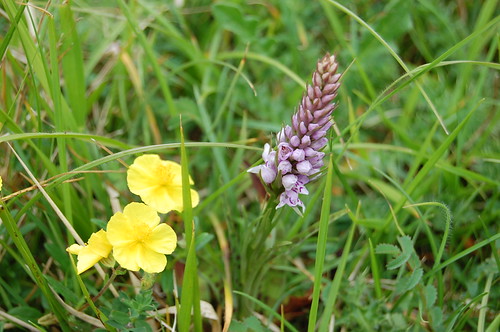
Rock rose (Helianthemum nummularium) growing next to a common spotted orchid (Dactylorhiza fuchsii) on Nottingham Hill.
These pictures were all taken on Sunday, when I went out for a walk up there on what seemed like a charmingly pleasant early summer day. I was having a great time grovelling about in the undergrowth with my camera when it became apparent that the distant booming I could hear was not some bizarre rural motorsport as I'd assumed but a rather formidable thunderstorm approaching very stealthily. I can't resist rainstorms ... they are an exhilarating manifestation of nature's power and they make me feel wonderful. So once I'd got my camera to a place of safety (just as the rain was starting) I went off up another footpath and climbed up onto a mini-hillock on the hillside and embraced the storm while it pelted down and soaked me. It was bliss!
I had to drive home with a wet arse, but it was worth it.
None of these are particularly rare plants, but I don't care, it's always a joy to see them.
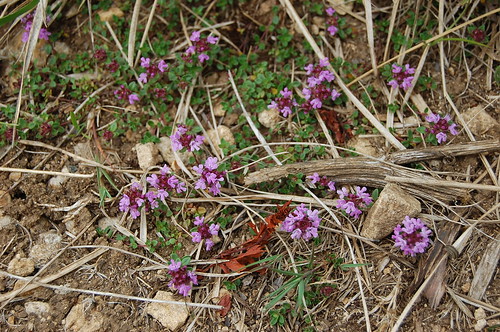
Wild thyme, which is a species called Thymus polytrichus. It looks like a miniature version of garden thyme and you certainly can take it home and sprinkle it on your pizza, but I've found Cotswold wild thyme to be decidedly lacking in the aromatic department, so I generally just admire it and use home-grown stuff for eating.

Yes I know this stuff is common as dirt. But it doesn't half look beautiful once you get down on your hands and knees for a proper look. Bird's foot trefoil, also known as Eggs and Bacon, and Lotus corniculatus.
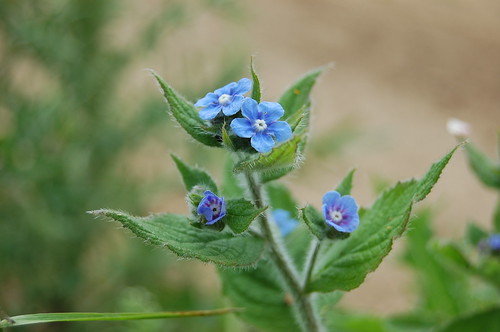
The decidedly blue flower known as green alkanet, and also by the glorious botanical name of Pentaglossis sempervirens.

Although it looks a bit like lady's bedstraw, this is the slightly more subtle crosswort (Cruciata laevipes). Most things with 'wort' in their name have a history of medicinal use.
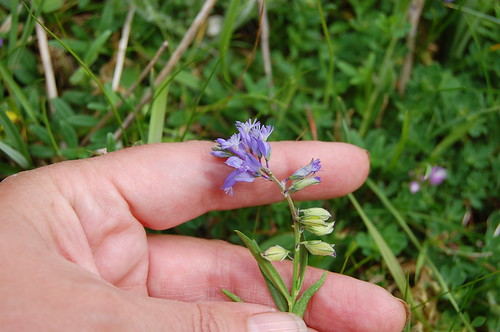
Another old healing herb, common milkwort (Polygala vulgaris) which I found in two shades of blue and a pink variant, all growing together in the same clump.
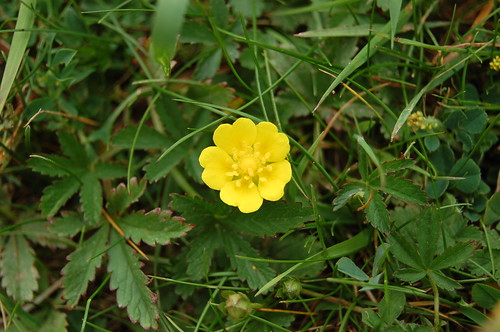
A particularly elegant blossom of creeping cinquefoil (Potentilla reptans).
One of the highlights of my walk was not a flower but a particularly beautiful moth. I don't know much about moths at all but these days all you need is a quick trawl of the interwebs to identify things.
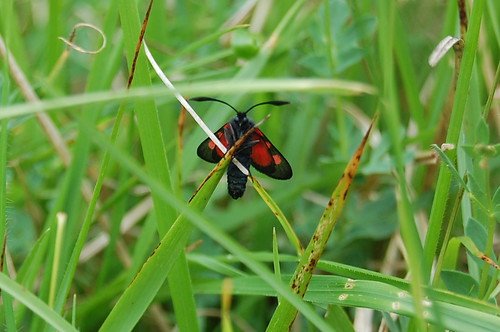

This gorgeous chap (two views of the same moth) is a five-spot burnet, or Zygaena trifolii if you prefer.
Finally, here's something that is in my garden.
I have a few wild plants naturalised in my garden, either because they've always been there or because I've introduced them through locally collected seeds. My house was built in the 1930s on land that was formerly a damson orchard, and I still have some damson trees in what was originally a field boundary at the back of my garden, and it's quite possible that some of the native wild flowers have stuck around here too.
At any rate, when I moved here in 2004 and started weeding the garden, which had been fallow for a year, I found a scarlet pimpernel with purply-mauve flowers instead of the usual pale red. I carefully weeded round it to give it a chance to mature and set seed. I wasn't sure whether the flower colour would come true from seed, but sure enough the following year there were more.
It's not particularly unusual to get colour variants in scarlet pimpernels. But blue is a more common one to find, or white. I'm not sure how widespread the mauvey purple ones are. But it certainly is a heritable trait because there's no variation from year to year. I try to help them colonise by carefully preserving all the pimpernels when I'm weeding and then removing a lot of the scarlet ones once they show their colour. Sometimes if I'm out there with my tweezers I grab an anther off one of the purples and dab it on the stigma of another purple on a different plant, just to make sure. But in all honesty it doesn't need my help, it's surviving fine by itself.
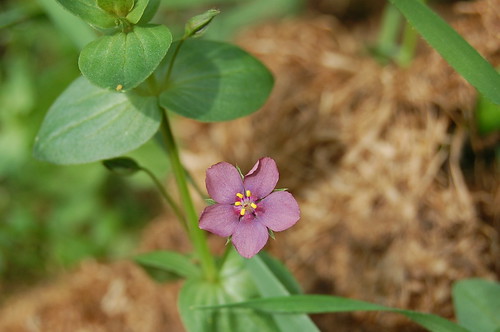
Violet-purple petals on a scarlet pimpernel, Anagallis arvensis. Native to my garden!
18 comments:
You take me back to my own walks on those hills. thanks.
We are wild-flower walkers too. My husband is a recorder for the Botanical Society of the British Isles so we are always on the look-out.
I have always pictured the Lotus Eaters as tucking into a plate of bacon and eggs but it's such an obscure idea that I've never shared it before!
I do like your purple pimpernel. I know that as Poor Man's Weather-glass because it opens in the sun (although by then you know it's sunny - maybe it should be called thick-man's weather-glass?)
We had a purplish one last year but it has not come through in this year's. My perfectionist gardening neighbour watches in puzzlement at my style of gardening.
I know what you mean about storms - all that elemental power. Anyone who thinks that humans are important just needs to experience a real storm to understand how small we are.
Unfortunately, stand on a hilltop around here in the middle of a storm and run the serious risk of being mistaken for a convenient lightening conductor ...
Great post, lovely photos, thanks.
There's something magical about limestone - both the rock itself and the exquisite flora that develops on it. The rhododendrons here don't seem to be adequate compensation for the absence of pasque flower, meadow cranesbill, melancholy thistle, rock rose.......
I've never seen a mauve scarlet pimpernel before. presumably there's some sort of combined action of red and blue alleles - codominance?
Glad you enjoyed it Jeremy.
Kath... thick-man's-weather-glass - that is funny. They also close up in the afternoon regardless of weather, so are not much use to late risers like me. Sounds like you have a similar neighbour situation to me ... mine have an immaculate sterile garden and find all my activities incomprehensible. Especially the seed saving - they cannot fathom why I grow vegetables and then don't eat them.
Bilbo ... I love elemental power! I'm not very good at resisting the lure of nature's beauty, and have a bit of a track record of throwing myself into Scottish lochs.
Owen ... now there's an intriguing thought. I admit I know absolutely nothing about how scarlet pimpernels reproduce but that colour does look to me like a halfway house between red and blue. But in six years I've never seen any segregation - which I would expect if it was in any way heterozygous. I find mostly scarlets and a handful of mauves. I would have thought I'd see some blues segregating out by now, but the mauve is absolutely consistent.
"...Of the fierce wind, while mid-day lightnings prowl
Insidiously, untimely thunders growl;
While trees, dim-seen, in frenzied numbers, tear
The lingering remnant of their yellow hair..."
W.W.
Braiding
Of floating flames across the mountain brow.
Brooding
Of stillness; and a sighing of the bough.
Stirs
Of leaflets in the gloom; soft petal-showers;
Stars
Expanding with the starr'd nocturnal flowers.
W.O.
Oh, you are living in that wonderful area, I have visited in May! Malvern Hills area is one of the most picturesque. You are truly blessed, girl.
Thank you Ewa. I was born only five miles from this hill and I still have to pinch myself to believe I live somewhere this beautiful.
To the person whose comment I removed: I have a strict no-advertising policy on this blog, even when the things you're promoting are in keeping with my ideals. If you'd to be treated as a human rather than a spammer, you're welcome to come back and leave a human comment.
Come on somebody - stick an Edward Thomas quote in. You know you want to.
Wow, that's an incredible photo of the storm. And the others are gorgeous too - you shame me with your plant knowledge!
Thank you Nome. I have to look up most of the Latin names 'cause I can never remember them.
It rains, and nothing stirs within the fence
Anywhere through the orchard's untrodden, dense
Forest of parsley. The great diamonds
Of rain on the grassblades there is none to break,
Or the fallen petals further down to shake.
And I am nearly as happy as possible
To search the wilderness in vain though well,
To think of two walking, kissing there,
Drenched, yet forgetting the kisses of the rain:
Sad, too, to think that never, never again,
Unless alone, so happy shall I walk
In the rain. When I turn away, on its fine stalk
Twilight has fined to naught, the parsley flower
Figures, suspended still and ghostly white,
The past hovering as it revisits the light.
Ah, yes.
Good job you didn't stick "E.T." at the bottom - it might have conjured up the wrong sort of images. BMXs and California, for example.
Yeah ... something didn't look quite right about it! We don't want alien poetry on the blog. I'm sure there are other sites for that.
Thank you for sharing. Wonderful post. I appreciate it.
A wildflower is a different story. It is an emotional thing. We cannot buy happiness. It is natural process, vary from people to people. It is a constructive post. Now it's time to avail Best regular cleaning services New York for more information.
Post a Comment